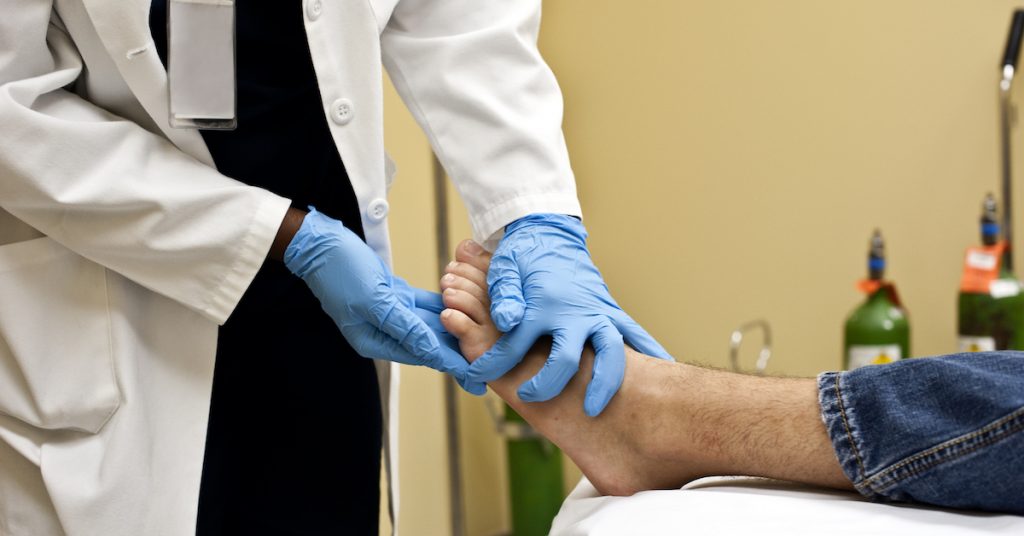
Approximately 25,000 people experience a sprained ankle or foot on a daily basis. A sprain occurs when one or more of the ligaments that stabilize and support the joint is stretched or torn as it is forced beyond its normal range of motion. FastMed Urgent Care clinics are equipped to diagnose and treat sprains and a wide range of sports-related injuries.
Types of Sprains
Sprains are classified based on the extent of the damage to the ligament. Grade I injuries involve a stretching of the ligaments and typically heal within a few days with the proper sprained ankle treatment. Grade II injuries typically require that the affected ankle be immobilized to allow time for the ligaments to heal. A Grade III injury is severe and represents a complete tear of the ligament which can make the ankle permanently unstable if not treated properly. In most cases, a cast or walking boot may be required for several weeks. In rare cases, surgery may be recommended to repair or tighten the damaged ligament.
Common Causes of a Sprained Ankle and Foot
Sprains are most likely to occur when you fall in a way that causes the ankle to twist, when walking or running on an uneven surface, during activities that require sudden jumping or pivoting, or when someone steps on your foot while you are in motion.
Those most at risk for experiencing sprained ankle symptoms include:
- Athletes
- Individuals who have had a previous ankle injury
- Those who wear high-heeled shoes or shoes that are not appropriate for the activity
- Individuals who attempt sports or other activities for which they are not properly conditioned
Common Sprained Ankle Symptoms
The symptoms of a sprained ankle can vary based on the severity of the damage to the ligaments. The most common symptoms include:
- Pain when putting weight on the affected foot
- Ankle injury swelling
- A feeling of instability in the ankle
- Reduced range of motion
- Bruising
- A “popping” sensation at the time of the injury
If the provider suspects a sprain based on the physical exam, he or she will likely use imaging scans, such as X-rays, MRIs, or CT scans to assess the extent of the damage and to rule out fractures (broken bones) and other types of injuries.
Sprained Ankle Treatment
The goal of sprained ankle treatment is to reduce the ankle injury swelling and pain, allow the damaged ligament time to heal, and to restore the strength and function of the injured ankle.
Mild to moderate sprains respond well to the R.I.C.E. approach. This involves resting the injured ankle for several days, applying ice to the affected area for 15 to 20 minutes several times a day for the first 24 hours, using elastic bandages to compress the ankle to reduce swelling, and keeping the injured ankle elevated above the heart to promote fluid drainage which reduces swelling. Over-the-counter pain relievers can also be used to alleviate any discomfort.
For severe sprains, crutches, casts, or a walking boot may be necessary to stabilize the ankle as the ligaments heal. If the ankle remains unstable after extensive therapy or the ligaments are badly damaged or won’t heal, surgery may be required.
What to Expect During Sprained Ankle Recovery
Regardless of the extent of the injury, sprained ankle recovery and rehabilitation occurs in three phases. The first phase involves resting and protecting the ankle and limiting the swelling. The second phase begins once you are able to put weight on the injured ankle. At this point, the provider or physical therapist will typically recommend exercises designed to increase muscle strength, balance, and stability and to restore flexibility and range of motion. During the third phase, you are allowed to gradually return to activities involving straight-ahead movements before graduating to activities that require cutting motions, such as basketball and tennis.
Preventing Sprained Ankles
There are steps that you can take to reduce your chances of suffering an ankle sprain:
- Make sure that you warm up properly before exercising or playing sports
- Wear appropriate shoes for your activity
- Avoid running or playing sports on uneven surfaces
- If you have weak ankles or have previously injured an ankle, use a brace or tape when exercising or playing sports
- Be realistic about your physical limits by avoiding activities or sports for which you are not properly conditioned
- Incorporate balance and stability exercises into your workout regimen
If you are experiencing sprained ankle symptoms, see a medical professional at your local FastMed clinic as soon as possible to avoid complications, including chronic ankle instability, repeat sprains, and arthritis. We are open seven days a week and offer extended hours to serve you and your family.
About FastMed
FastMed Urgent Care owns and operates nearly 200 centers in North Carolina, Arizona and Texas that provide a broad range of acute/episodic and preventive healthcare services 365 days a year. FastMed also provides workers’ compensation and other occupational health services at all its centers, and family and sports medicine services at select locations. FastMed has successfully treated more than six million patients and is the only independent urgent care operator in North Carolina, Arizona and Texas to be awarded The Joint Commission’s Gold Seal of Approval® for quality, safety and infection control in ambulatory healthcare. For more information about locations, services, hours of operation, insurance and prices, visit www.fastmed.com.